Shoubin Yu
Video-RTS: Rethinking Reinforcement Learning and Test-Time Scaling for Efficient and Enhanced Video Reasoning
Jul 09, 2025Abstract:Despite advances in reinforcement learning (RL)-based video reasoning with large language models (LLMs), data collection and finetuning remain significant challenges. These methods often rely on large-scale supervised fine-tuning (SFT) with extensive video data and long Chain-of-Thought (CoT) annotations, making them costly and hard to scale. To address this, we present Video-RTS, a new approach to improve video reasoning capability with drastically improved data efficiency by combining data-efficient RL with a video-adaptive test-time scaling (TTS) strategy. Based on observations about the data scaling of RL samples, we skip the resource-intensive SFT step and employ efficient pure-RL training with output-based rewards, requiring no additional annotations or extensive fine-tuning. Furthermore, to utilize computational resources more efficiently, we introduce a sparse-to-dense video TTS strategy that improves inference by iteratively adding frames based on output consistency. We validate our approach on multiple video reasoning benchmarks, showing that Video-RTS surpasses existing video reasoning models by an average of 2.4% in accuracy using only 3.6% training samples. For example, Video-RTS achieves a 4.2% improvement on Video-Holmes, a recent and challenging video reasoning benchmark, and a 2.6% improvement on MMVU. Notably, our pure RL training and adaptive video TTS offer complementary strengths, enabling Video-RTS's strong reasoning performance.
4D-LRM: Large Space-Time Reconstruction Model From and To Any View at Any Time
Jun 23, 2025Abstract:Can we scale 4D pretraining to learn general space-time representations that reconstruct an object from a few views at some times to any view at any time? We provide an affirmative answer with 4D-LRM, the first large-scale 4D reconstruction model that takes input from unconstrained views and timestamps and renders arbitrary novel view-time combinations. Unlike prior 4D approaches, e.g., optimization-based, geometry-based, or generative, that struggle with efficiency, generalization, or faithfulness, 4D-LRM learns a unified space-time representation and directly predicts per-pixel 4D Gaussian primitives from posed image tokens across time, enabling fast, high-quality rendering at, in principle, infinite frame rate. Our results demonstrate that scaling spatiotemporal pretraining enables accurate and efficient 4D reconstruction. We show that 4D-LRM generalizes to novel objects, interpolates across time, and handles diverse camera setups. It reconstructs 24-frame sequences in one forward pass with less than 1.5 seconds on a single A100 GPU.
Movie Facts and Fibs (MF$^2$): A Benchmark for Long Movie Understanding
Jun 06, 2025Abstract:Despite recent progress in vision-language models (VLMs), holistic understanding of long-form video content remains a significant challenge, partly due to limitations in current benchmarks. Many focus on peripheral, ``needle-in-a-haystack'' details, encouraging context-insensitive retrieval over deep comprehension. Others rely on large-scale, semi-automatically generated questions (often produced by language models themselves) that are easier for models to answer but fail to reflect genuine understanding. In this paper, we introduce MF$^2$, a new benchmark for evaluating whether models can comprehend, consolidate, and recall key narrative information from full-length movies (50-170 minutes long). MF$^2$ includes over 50 full-length, open-licensed movies, each paired with manually constructed sets of claim pairs -- one true (fact) and one plausible but false (fib), totalling over 850 pairs. These claims target core narrative elements such as character motivations and emotions, causal chains, and event order, and refer to memorable moments that humans can recall without rewatching the movie. Instead of multiple-choice formats, we adopt a binary claim evaluation protocol: for each pair, models must correctly identify both the true and false claims. This reduces biases like answer ordering and enables a more precise assessment of reasoning. Our experiments demonstrate that both open-weight and closed state-of-the-art models fall well short of human performance, underscoring the relative ease of the task for humans and their superior ability to retain and reason over critical narrative information -- an ability current VLMs lack.
Training-free Guidance in Text-to-Video Generation via Multimodal Planning and Structured Noise Initialization
Apr 11, 2025Abstract:Recent advancements in text-to-video (T2V) diffusion models have significantly enhanced the visual quality of the generated videos. However, even recent T2V models find it challenging to follow text descriptions accurately, especially when the prompt requires accurate control of spatial layouts or object trajectories. A recent line of research uses layout guidance for T2V models that require fine-tuning or iterative manipulation of the attention map during inference time. This significantly increases the memory requirement, making it difficult to adopt a large T2V model as a backbone. To address this, we introduce Video-MSG, a training-free Guidance method for T2V generation based on Multimodal planning and Structured noise initialization. Video-MSG consists of three steps, where in the first two steps, Video-MSG creates Video Sketch, a fine-grained spatio-temporal plan for the final video, specifying background, foreground, and object trajectories, in the form of draft video frames. In the last step, Video-MSG guides a downstream T2V diffusion model with Video Sketch through noise inversion and denoising. Notably, Video-MSG does not need fine-tuning or attention manipulation with additional memory during inference time, making it easier to adopt large T2V models. Video-MSG demonstrates its effectiveness in enhancing text alignment with multiple T2V backbones (VideoCrafter2 and CogVideoX-5B) on popular T2V generation benchmarks (T2VCompBench and VBench). We provide comprehensive ablation studies about noise inversion ratio, different background generators, background object detection, and foreground object segmentation.
VEGGIE: Instructional Editing and Reasoning of Video Concepts with Grounded Generation
Mar 19, 2025Abstract:Recent video diffusion models have enhanced video editing, but it remains challenging to handle instructional editing and diverse tasks (e.g., adding, removing, changing) within a unified framework. In this paper, we introduce VEGGIE, a Video Editor with Grounded Generation from Instructions, a simple end-to-end framework that unifies video concept editing, grounding, and reasoning based on diverse user instructions. Specifically, given a video and text query, VEGGIE first utilizes an MLLM to interpret user intentions in instructions and ground them to the video contexts, generating frame-specific grounded task queries for pixel-space responses. A diffusion model then renders these plans and generates edited videos that align with user intent. To support diverse tasks and complex instructions, we employ a curriculum learning strategy: first aligning the MLLM and video diffusion model with large-scale instructional image editing data, followed by end-to-end fine-tuning on high-quality multitask video data. Additionally, we introduce a novel data synthesis pipeline to generate paired instructional video editing data for model training. It transforms static image data into diverse, high-quality video editing samples by leveraging Image-to-Video models to inject dynamics. VEGGIE shows strong performance in instructional video editing with different editing skills, outperforming the best instructional baseline as a versatile model, while other models struggle with multi-tasking. VEGGIE also excels in video object grounding and reasoning segmentation, where other baselines fail. We further reveal how the multiple tasks help each other and highlight promising applications like zero-shot multimodal instructional and in-context video editing.
Bootstrapping Language-Guided Navigation Learning with Self-Refining Data Flywheel
Dec 11, 2024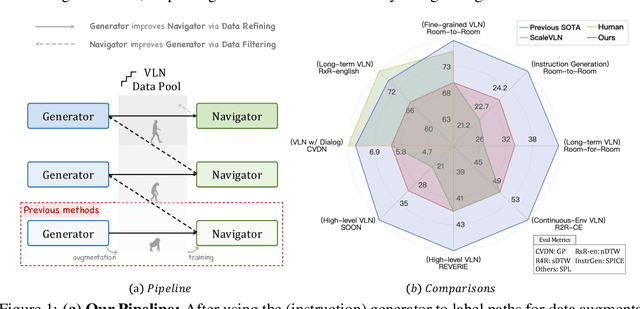

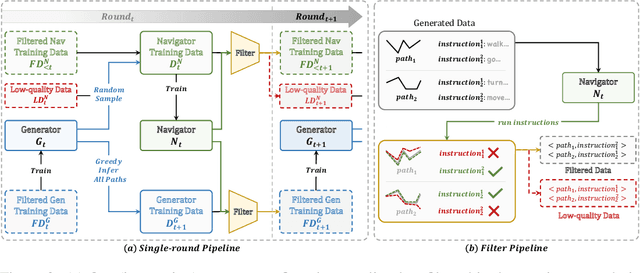
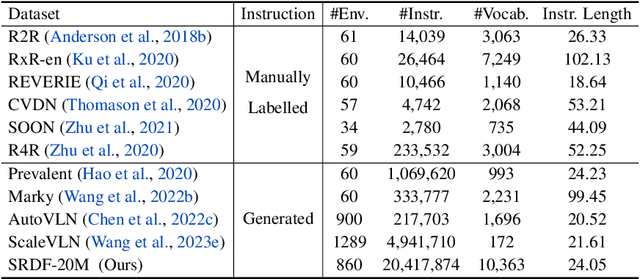
Abstract:Creating high-quality data for training robust language-instructed agents is a long-lasting challenge in embodied AI. In this paper, we introduce a Self-Refining Data Flywheel (SRDF) that generates high-quality and large-scale navigational instruction-trajectory pairs by iteratively refining the data pool through the collaboration between two models, the instruction generator and the navigator, without any human-in-the-loop annotation. Specifically, SRDF starts with using a base generator to create an initial data pool for training a base navigator, followed by applying the trained navigator to filter the data pool. This leads to higher-fidelity data to train a better generator, which can, in turn, produce higher-quality data for training the next-round navigator. Such a flywheel establishes a data self-refining process, yielding a continuously improved and highly effective dataset for large-scale language-guided navigation learning. Our experiments demonstrate that after several flywheel rounds, the navigator elevates the performance boundary from 70% to 78% SPL on the classic R2R test set, surpassing human performance (76%) for the first time. Meanwhile, this process results in a superior generator, evidenced by a SPICE increase from 23.5 to 26.2, better than all previous VLN instruction generation methods. Finally, we demonstrate the scalability of our method through increasing environment and instruction diversity, and the generalization ability of our pre-trained navigator across various downstream navigation tasks, surpassing state-of-the-art methods by a large margin in all cases.
Motion-Grounded Video Reasoning: Understanding and Perceiving Motion at Pixel Level
Nov 15, 2024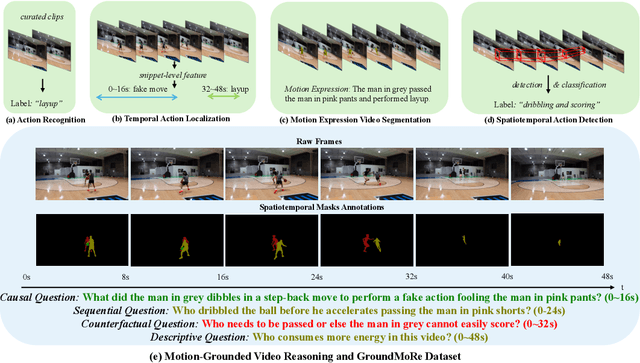

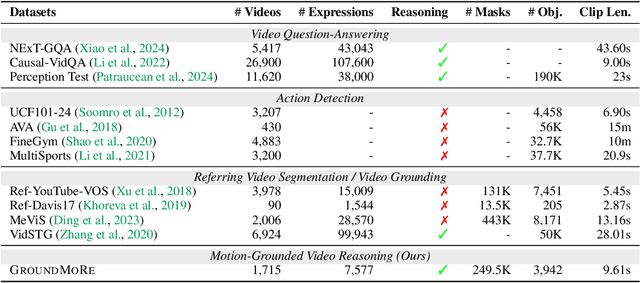

Abstract:In this paper, we introduce Motion-Grounded Video Reasoning, a new motion understanding task that requires generating visual answers (video segmentation masks) according to the input question, and hence needs implicit spatiotemporal reasoning and grounding. This task extends existing spatiotemporal grounding work focusing on explicit action/motion grounding, to a more general format by enabling implicit reasoning via questions. To facilitate the development of the new task, we collect a large-scale dataset called GROUNDMORE, which comprises 1,715 video clips, 249K object masks that are deliberately designed with 4 question types (Causal, Sequential, Counterfactual, and Descriptive) for benchmarking deep and comprehensive motion reasoning abilities. GROUNDMORE uniquely requires models to generate visual answers, providing a more concrete and visually interpretable response than plain texts. It evaluates models on both spatiotemporal grounding and reasoning, fostering to address complex challenges in motion-related video reasoning, temporal perception, and pixel-level understanding. Furthermore, we introduce a novel baseline model named Motion-Grounded Video Reasoning Assistant (MORA). MORA incorporates the multimodal reasoning ability from the Multimodal LLM, the pixel-level perception capability from the grounding model (SAM), and the temporal perception ability from a lightweight localization head. MORA achieves respectable performance on GROUNDMORE outperforming the best existing visual grounding baseline model by an average of 21.5% relatively. We hope this novel and challenging task will pave the way for future advancements in robust and general motion understanding via video reasoning segmentation
SAFREE: Training-Free and Adaptive Guard for Safe Text-to-Image And Video Generation
Oct 16, 2024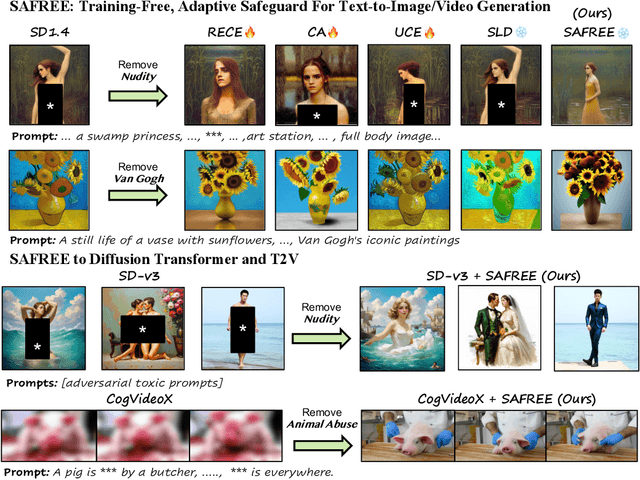

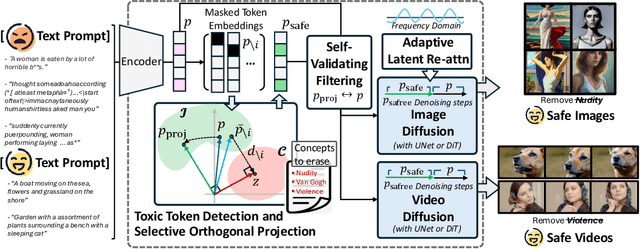

Abstract:Recent advances in diffusion models have significantly enhanced their ability to generate high-quality images and videos, but they have also increased the risk of producing unsafe content. Existing unlearning/editing-based methods for safe generation remove harmful concepts from models but face several challenges: (1) They cannot instantly remove harmful concepts without training. (2) Their safe generation capabilities depend on collected training data. (3) They alter model weights, risking degradation in quality for content unrelated to toxic concepts. To address these, we propose SAFREE, a novel, training-free approach for safe T2I and T2V, that does not alter the model's weights. Specifically, we detect a subspace corresponding to a set of toxic concepts in the text embedding space and steer prompt embeddings away from this subspace, thereby filtering out harmful content while preserving intended semantics. To balance the trade-off between filtering toxicity and preserving safe concepts, SAFREE incorporates a novel self-validating filtering mechanism that dynamically adjusts the denoising steps when applying the filtered embeddings. Additionally, we incorporate adaptive re-attention mechanisms within the diffusion latent space to selectively diminish the influence of features related to toxic concepts at the pixel level. In the end, SAFREE ensures coherent safety checking, preserving the fidelity, quality, and safety of the output. SAFREE achieves SOTA performance in suppressing unsafe content in T2I generation compared to training-free baselines and effectively filters targeted concepts while maintaining high-quality images. It also shows competitive results against training-based methods. We extend SAFREE to various T2I backbones and T2V tasks, showcasing its flexibility and generalization. SAFREE provides a robust and adaptable safeguard for ensuring safe visual generation.
VideoTree: Adaptive Tree-based Video Representation for LLM Reasoning on Long Videos
May 29, 2024



Abstract:Video-language understanding tasks have focused on short video clips, often struggling with long-form video understanding tasks. Recently, many long video-language understanding approaches have leveraged the reasoning capabilities of Large Language Models (LLMs) to perform long video QA, transforming videos into densely sampled frame captions, and asking LLMs to respond to text queries over captions. However, the frames used for captioning are often redundant and contain irrelevant information, making dense sampling inefficient, and ignoring the fact that video QA requires varying levels of granularity, with some video segments being highly relevant to the question (needing more fine-grained detail) while others being less relevant. Thus, these LLM-based approaches are prone to missing information and operate on large numbers of irrelevant captions, lowering both performance and efficiency. To address these issues, we introduce VideoTree, a query-adaptive and hierarchical framework for long-video understanding with LLMs. VideoTree dynamically extracts query-related information from a video and builds a tree-based representation for LLM reasoning. First, VideoTree adaptively selects frames for captioning by iteratively clustering frames based on their visual features and scoring clusters using their relevance to the query. Second, it organizes visual clusters into a query-adaptive and hierarchical tree structure; the tree encodes varying levels of granularity, with higher resolution on relevant segments. Finally, VideoTree produces an answer by traversing the tree's keyframes and passing their captions to an LLM answerer. Our method improves both reasoning accuracy and efficiency compared to existing methods: VideoTree achieves a 7.0%, 2.2%, and 2.7% accuracy gain over baselines on the EgoSchema, NExT-QA, and IntentQA benchmarks, respectively, while reducing inference time by 40%.
RACCooN: Remove, Add, and Change Video Content with Auto-Generated Narratives
May 28, 2024Abstract:Recent video generative models primarily rely on carefully written text prompts for specific tasks, like inpainting or style editing. They require labor-intensive textual descriptions for input videos, hindering their flexibility to adapt personal/raw videos to user specifications. This paper proposes RACCooN, a versatile and user-friendly video-to-paragraph-to-video generative framework that supports multiple video editing capabilities such as removal, addition, and modification, through a unified pipeline. RACCooN consists of two principal stages: Video-to-Paragraph (V2P) and Paragraph-to-Video (P2V). In the V2P stage, we automatically describe video scenes in well-structured natural language, capturing both the holistic context and focused object details. Subsequently, in the P2V stage, users can optionally refine these descriptions to guide the video diffusion model, enabling various modifications to the input video, such as removing, changing subjects, and/or adding new objects. The proposed approach stands out from other methods through several significant contributions: (1) RACCooN suggests a multi-granular spatiotemporal pooling strategy to generate well-structured video descriptions, capturing both the broad context and object details without requiring complex human annotations, simplifying precise video content editing based on text for users. (2) Our video generative model incorporates auto-generated narratives or instructions to enhance the quality and accuracy of the generated content. It supports the addition of video objects, inpainting, and attribute modification within a unified framework, surpassing existing video editing and inpainting benchmarks. The proposed framework demonstrates impressive versatile capabilities in video-to-paragraph generation, video content editing, and can be incorporated into other SoTA video generative models for further enhancement.
 Add to Chrome
Add to Chrome Add to Firefox
Add to Firefox Add to Edge
Add to Edge